 J from West, who would lead this card from a suit headed by
J from West, who would lead this card from a suit headed by  J10 or
J10 or  KJ10. Which card would you play from the dummy on the first trick: the
KJ10. Which card would you play from the dummy on the first trick: the  A or the
A or the  Q? Here are the combined hands:
Q? Here are the combined hands:CHAPTER 16
General Principles
’Lady Coote and Gerald Wade were amiable and discursive and the young man never failed to say at the conclusion of each hand, “I say, partner, you played that simply splendidly,” in tones of simple admiration which Lady Coote found both novel and extremely soothing. They also held very good cards.’
From The Seven Dials Mystery by Agatha Christie
The play of the hand can be a high point in the game of bridge and many of us, like Lady Coote, find it extremely soothing when our partner notices that we played a hand well. After all, we are representing the partnership as the declarer when trying to take the number of tricks that we committed to in the auction. Taking tricks is what the game is all about. If the declarer takes enough tricks to fulfil the contract, his side collects points and if he is not successful, the opponents collect points. The play of the hand, or declarer play, is the focus of this book. We’ll let you in on some of the secrets of the experts and show you the methods they use to get the most from the cards.
Making a plan
Since the declarer is responsible for both his own hand and the dummy’s hand, we will focus on his decisions. In this book, the declarer will always be sitting in the South position and the dummy will be in the North position. Before we get any further, though, we want to ask you a question. Since this is a book on play, let’s get right to the point. You are playing in a contract of 2NT. This means that you have to take eight tricks to make your contract, and there is no trump suit. The opening lead is the  J from West, who would lead this card from a suit headed by
J from West, who would lead this card from a suit headed by  J10 or
J10 or  KJ10. Which card would you play from the dummy on the first trick: the
KJ10. Which card would you play from the dummy on the first trick: the  A or the
A or the  Q? Here are the combined hands:
Q? Here are the combined hands:

More important than whether you decide to play the  A or the
A or the  Q is the way you arrive at your decision. Before you choose the particular card to play in a specific suit, whether it is your first hand or whether you are a world-class player, you have to take a look at the big picture. You have to make a plan.
Q is the way you arrive at your decision. Before you choose the particular card to play in a specific suit, whether it is your first hand or whether you are a world-class player, you have to take a look at the big picture. You have to make a plan.
There are many different aspects to making a plan and many considerations. Most important is the concept that you have to stop and take a moment to decide how you are going to make your contract. The letters S T O P can be used to help remember the steps you go through on nearly every hand you play.
|
S |
– stop to consider your goal |
|
T |
– tally your winners |
|
O |
– organize your plan |
|
P |
– put your plan into operation |
Stop to consider your goal
The first step in playing a hand is to consider your goal. In other words, how many tricks do you need to take to make your contract? Does this sound too simple? It is the only way you can decide whether to play the  A or the
A or the  Q in the hand above. You are in 2NT and so have set your sights on taking eight tricks.
Q in the hand above. You are in 2NT and so have set your sights on taking eight tricks.
Tally your winners
After you have stopped to consider your goal, the next step is to discover how close you are to getting there. Tally your winners. A winner, or a sure trick, is one you can take without giving up the lead to the opponents. Here are two examples to illustrate the point:

You have two tricks in this suit, one with the  A and another with the
A and another with the  K. You can take both of these tricks without giving up the lead to the opponents.
K. You can take both of these tricks without giving up the lead to the opponents.
Now, how many sure tricks arc there in this suit?
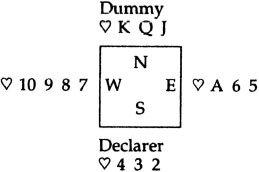
After the  A is driven out – that is, after East has played the
A is driven out – that is, after East has played the  A in order to capture one of dummy’s high cards – the declarer will be able to take two tricks. However, there are no sure tricks since, by definition, sure tricks refer to those you can take without giving up the lead to the opponents.
A in order to capture one of dummy’s high cards – the declarer will be able to take two tricks. However, there are no sure tricks since, by definition, sure tricks refer to those you can take without giving up the lead to the opponents.
Three more ideas about sure tricks are worth noting. First, the declarer does not need to have all of the high cards in one hand. Each of the following examples has three sure tricks: one with the ace, one with the king and one with the queen.

Secondly, you cannot take any more sure tricks than the number of cards in the hand with the greater number of cards in the suit.

In the first example, although you have the top four high cards, you can take only two sure tricks since both the declarer and the dummy each has only two cards in the suit. In the next example, although you have only two of the high cards, you still take two sure tricks. Those extra high cards in the first example – the  QJ in dummy instead of the
QJ in dummy instead of the  32 – did not do you any good, because of the rule which says that declarer has to play a card from both hands to each trick! When you play the
32 – did not do you any good, because of the rule which says that declarer has to play a card from both hands to each trick! When you play the  A from the South hand, you must follow suit with the
A from the South hand, you must follow suit with the  J from the North hand, and when you next play the
J from the North hand, and when you next play the  K from South you must follow with the
K from South you must follow with the  Q from North. In the final example, you have the four top cards, but can take at most three winners, since you have only a three-card suit in the dummy. In fact, you may not even be able to take three winners – after cashing the
Q from North. In the final example, you have the four top cards, but can take at most three winners, since you have only a three-card suit in the dummy. In fact, you may not even be able to take three winners – after cashing the  A and the
A and the  K, the lead will be in the South hand. If you cannot get to dummy in another suit to cash the
K, the lead will be in the South hand. If you cannot get to dummy in another suit to cash the  Q, you will never make a trick with it! (Note: to cash a card means to play a sure winner and take the trick with it.)
Q, you will never make a trick with it! (Note: to cash a card means to play a sure winner and take the trick with it.)
Another consideration is that when the cards are unevenly divided between your hand and the dummy, you may have to play the cards in a certain order to enable you to collect all of your sure tricks. Take this example:

You have the six top cards: the ace, king, queen, jack, ten and nine. You have a six-card suit in your hand, so you can expect to take six tricks. The order in which you play the cards, however, can be important. If you play the  A and then a small diamond to the
A and then a small diamond to the  K, you are in the dummy. You have no more diamonds left to get back to your hand. If you can get there in another suit, fine, but this is not always the case.
K, you are in the dummy. You have no more diamonds left to get back to your hand. If you can get there in another suit, fine, but this is not always the case.
Play the suit again. This time play a small diamond to the  K in the dummy. Next, play a low diamond to the high cards in your hand. Now you can easily take all six tricks. The idea is to get to your long side. You want to get rid of the high card, the
K in the dummy. Next, play a low diamond to the high cards in your hand. Now you can easily take all six tricks. The idea is to get to your long side. You want to get rid of the high card, the  K in the dummy, on the first trick so that it does not get in the way of your getting back to your hand. This is referred to as playing the high card from the short side.
K in the dummy, on the first trick so that it does not get in the way of your getting back to your hand. This is referred to as playing the high card from the short side.
Another example:

You have the top four cards, and dummy has a four-card suit, so you should have four sure tricks. In order to take them, though, you must be careful to follow the rule and play your high cards from the short side first. You must cash the  A, playing dummy’s
A, playing dummy’s  2, then the
2, then the  K playing dummy’s
K playing dummy’s  7. Next lead the
7. Next lead the  3 to dummy’s
3 to dummy’s  J, and you will be in the right hand to cash the
J, and you will be in the right hand to cash the  Q. Work out for yourself what might happen if you lead the
Q. Work out for yourself what might happen if you lead the  3 on either the first or the second round of the suit.
3 on either the first or the second round of the suit.
Organize your plan
You want to look at the choices you have. If you have enough sure tricks to make your contract, then you should consider whether there are any special considerations – such as playing high cards from the short side first – that you need to be careful about when taking your tricks. If you do not have enough sure tricks to make your contract, then you should consider various ways to generate extra tricks. Let us go back to our example hand at the beginning of the chapter.

You have the option of playing either the  A or the
A or the  Q on the first trick. If you needed an extra winner apart from your sure tricks to make your contract of 2NT, then you would think about playing the
Q on the first trick. If you needed an extra winner apart from your sure tricks to make your contract of 2NT, then you would think about playing the  Q. But the first two steps of your plan should tell you that you don’t need any extra winners to make your contract. Your goal is to take eight tricks and you have the eight sure tricks that you need. On this hand, you don’t need to plan to consider ways of developing extra tricks.
Q. But the first two steps of your plan should tell you that you don’t need any extra winners to make your contract. Your goal is to take eight tricks and you have the eight sure tricks that you need. On this hand, you don’t need to plan to consider ways of developing extra tricks.
Put your plan into operation
Only after you have gone through the first three steps of your plan are you ready to play a card to the first trick. Let’s return to our original question: should you play the  A or the
A or the  Q on the first trick?
Q on the first trick?
Stop to consider your goal
You are in a contract of 2NT and so need to take eight tricks. Simple as that! Your goal is to take eight tricks.
Tally your winners
Remember that a winner is a trick that you take without giving up the lead to the opponents. Looking at the cards you hold in each suit, count your sure tricks as follows:
|
Spades |
1 sure trick with the |
|
Hearts |
0 sure tricks |
|
Diamonds |
3 sure tricks with the |
|
Clubs |
4 sure tricks with the |
The total is eight tricks. You have enough tricks to reach your goal.
Organize your plan
You have the option to play either the  Q or the
Q or the  A on the first trick. Having gone through the first two steps, you know that you have the tricks you need. Therefore, you should take them. Your priority is to take enough tricks to make your contract. By playing the
A on the first trick. Having gone through the first two steps, you know that you have the tricks you need. Therefore, you should take them. Your priority is to take enough tricks to make your contract. By playing the  A you can do this. If you were to play the
A you can do this. If you were to play the  Q, you might get an extra trick but you may also put the contract, unnecessarily, in jeopardy.
Q, you might get an extra trick but you may also put the contract, unnecessarily, in jeopardy.
Put your plan into operation
Play the  A, not the
A, not the  Q on the first trick, and then take your sure tricks.
Q on the first trick, and then take your sure tricks.
Let’s look at the entire hand:
Contract: 2NT

If you play the  Q on the first trick, East will win the trick with the
Q on the first trick, East will win the trick with the  K and lead back a heart. The defenders can take one spade trick and five heart tricks to defeat your contract.
K and lead back a heart. The defenders can take one spade trick and five heart tricks to defeat your contract.
Let’s look at this same hand again, making one small change. This time, you are in a contract of 3 NT. The lead is again the  J. The question remains the same: What do you play on the first trick: the
J. The question remains the same: What do you play on the first trick: the  A or the
A or the  Q?
Q?
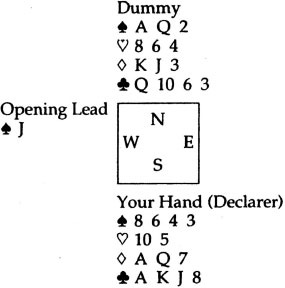
S T O P
Stop to consider your goal
This time, in a contract of 3NT, you need nine tricks.
Tally your winners
You still have eight winners.
Organize your plan
You need one more trick to make the contract. If you play the  A on the first trick, as you did in the first hand, you will take eight tricks, not enough to make 3NT. Where can you develop an extra trick? None of the other suits provides an opportunity to get the extra winner you need. Your best chance to develop an extra trick is to play the
A on the first trick, as you did in the first hand, you will take eight tricks, not enough to make 3NT. Where can you develop an extra trick? None of the other suits provides an opportunity to get the extra winner you need. Your best chance to develop an extra trick is to play the  Q on the first trick and hope that East does not have the
Q on the first trick and hope that East does not have the  K.
K.
Put your plan into operation
Having gone through your plan, you can see that the only way of getting an extra trick is in spades. Play the  Q. This time, let’s see what the opponents hold:
Q. This time, let’s see what the opponents hold:
Contract: 3NT
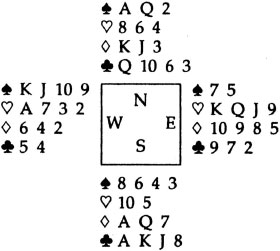
The way the cards lie this time, by playing the  Q on the first trick you are able to take two spade tricks, three diamond tricks and four club tricks for a total of nine tricks. You meet your goal. Of course, you might have ended up taking only seven tricks if the opponents’ cards were located as they were in the first hand, but you had no choice in a contract of 3NT. You needed to take nine tricks. You are not risking your contract by playing the
Q on the first trick you are able to take two spade tricks, three diamond tricks and four club tricks for a total of nine tricks. You meet your goal. Of course, you might have ended up taking only seven tricks if the opponents’ cards were located as they were in the first hand, but you had no choice in a contract of 3NT. You needed to take nine tricks. You are not risking your contract by playing the  Q because, if you don’t take that chance, you can’t take nine tricks. The point is that you don’t want to take any unnecessary chances. In the first hand, you had enough tricks to make your contract and there was no need to jeopardize that by trying for an extra trick.
Q because, if you don’t take that chance, you can’t take nine tricks. The point is that you don’t want to take any unnecessary chances. In the first hand, you had enough tricks to make your contract and there was no need to jeopardize that by trying for an extra trick.
Summary
Before you decide what card to play on any particular trick, Stop to consider the total picture. What is your goal? Tally your winners: how close are you to reaching your goal? Organize your plan: either to take your winners if you have enough to make the contract, or to develop a way of getting the extra winners you need. Finally, Put the plan into operation. Only after you have gone through all the steps of the plan should you play a card to the first trick.
Over Zia’s shoulder
Let’s watch Zia in action to see how even a world-class player has to STOP and make a plan before deciding on what card to play in a specific suit. At the end of each chapter, Zia will play three hands with you. Zia is always sitting in the South position so that you can look over his shoulder.
On each hand, we will give the auction first, along with Zia’s comments. Then you can see the opening lead and both your hand and the dummy. Examine the hand to see how you would plan to play it and then turn the page to see how Zia tackles the hand.
Here’s our first hand:
Hand 1 Dealer: South

|
N |
E |
S |
W |
|
2NT |
Pass |
||
|
6NT |
Pass |
Pass |
Pass |
On this first deal, I have dealt myself an attractive hand and we have ended up in my second favourite contract. I am sure you know my favourite?, Yes, 7NT!
After an opening lead of the  K, I am pleased to see my partner’s dummy and I am certainly planning to go through our S T O P procedure in such an important contract. How are we going to make our slam contract?
K, I am pleased to see my partner’s dummy and I am certainly planning to go through our S T O P procedure in such an important contract. How are we going to make our slam contract?
Solution to Hand 1:
Contract: 6NT

|
S |
Stop to consider the goal. We need twelve tricks. |
||||||||||||
|
T |
Tally the winners. This is a most enjoyable pastime: |
||||||||||||
|
|
|
||||||||||||
|
O |
Organize the plan Well, it looks as if we don’t need to develop extra tricks. As often does happen, we plan to take our sure tricks and make the contract. |
||||||||||||
|
P |
Put the plan into operation. This time it is simple – but there is one important rule that we should not overlook! We have two suits that are unevenly divided – spades and diamonds. We must remember to play the high cards from the short side first in these two suits. The sequence of plays should be: Win trick 1 with the Next cash dummy’s Return to the |
|
Things are going well. We’ve made a slam, and we’ve only just started playing! |
Hand 2 Dealer: North
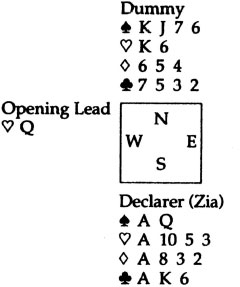
|
N |
E |
S |
W |
|
Pass |
Pass |
2NT |
Pass |
|
3NT |
Pass |
Pass |
Pass |
It often happens that you get two powerful hands in a row. Can we make two contracts in succession?
Solution to Hand 2:
Contract: 3NT
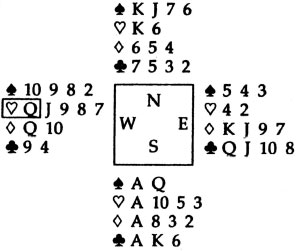
This is a very good hand to play together because it often catches those who don’t remember to STOP before playing the first card.
|
S |
We need nine tricks. |
||
|
T |
We tally our sure tricks. |
||
|
Spades |
4 winners: |
the four top cards |
|
|
Hearts |
2 winners: |
the |
|
|
Diamonds |
1 winner: |
the |
|
|
Clubs |
2 winners: |
the |
|
|
O |
We organize our plan. Since we have nine tricks, enough to make the contract provided we don’t make any careless mistakes, we don’t need to look for extra tricks. High cards in a suit are of no use unless we can get to them. The |
||
|
P |
We put the plan into operation. We play the |
||
Hand 3 Dealer: West
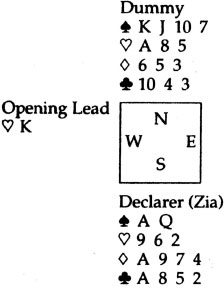
|
N |
E |
S |
W |
|
Pass |
|||
|
Pass |
Pass |
1NT |
Pass |
|
Pass |
Pass |
A quiet auction to a quiet contract. Nonetheless, we mustn’t lose sight of our goal. Even a little hand like this can require some careful planning.
Solution to Hand 3:
Contract: 1NT

|
S |
Stop to consider the goal. To make 1NT, we need seven tricks. |
||
|
T |
Tally the winners. |
||
|
Spades |
4 winners: |
|
|
|
Hearts |
1 winner: |
|
|
|
Diamonds |
1 winner: |
|
|
|
Clubs |
1 winner: |
|
|
|
O |
Organize the plan. We only require seven tricks this time and we appear to have the tricks we need. However, the lead of the |
||
|
P |
Put the plan into operation. |
||
Win the  A, play the
A, play the  A and then the
A and then the  Q, overtaking with the dummy’s
Q, overtaking with the dummy’s  K. Take the dummy’s
K. Take the dummy’s  J and
J and  10 and then your
10 and then your  A and
A and  A – and it’s on to the next chapter. Well, if you made all three hands, you’re well on your way to becoming a good declarer.
A – and it’s on to the next chapter. Well, if you made all three hands, you’re well on your way to becoming a good declarer.